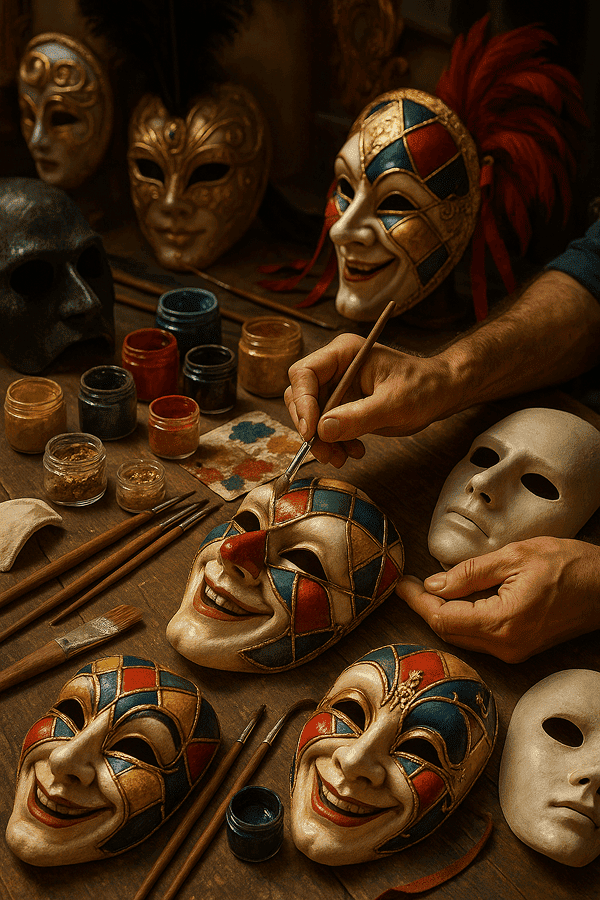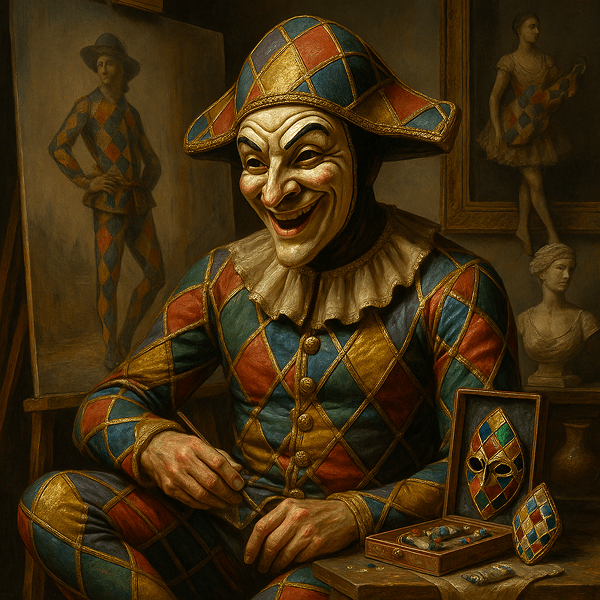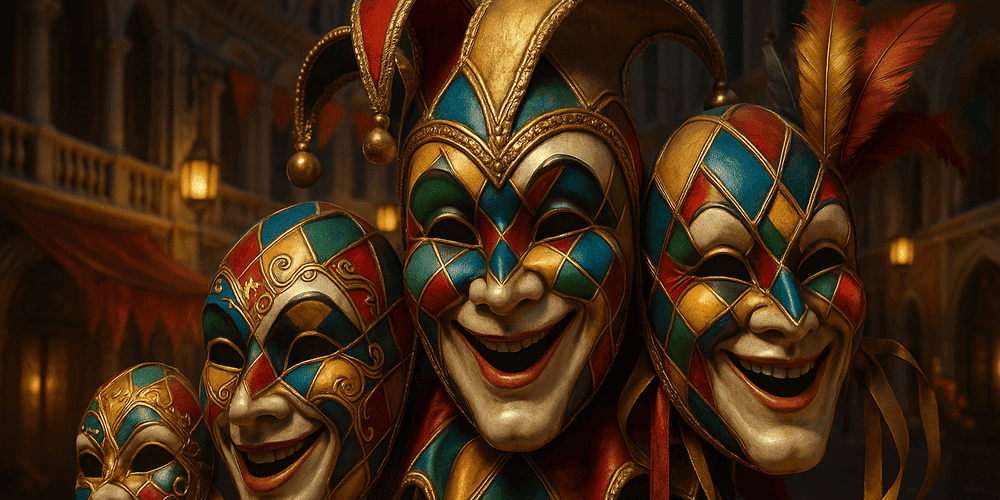The Harlequin Mask, or “Maschera di Arlecchino,” is one of the most instantly recognizable and beloved symbols of Venetian culture and European theatrical tradition. Characterized by its playful, mischievous expression and geometric, multicolored diamond patterns, the Harlequin Mask is traditionally part of the commedia dell’arte — a form of improvisational theater that flourished in Italy from the 16th century onwards. The mask typically covers the upper part of the face and sometimes the nose, leaving the mouth free for exaggerated expression. Its most distinctive features include bold, contrasting colors, a sly or whimsical grin, and occasionally raised eyebrows or a pointed hat. The Harlequin Mask is a centerpiece of Venetian masquerade balls, Carnival festivities, and theatrical performances, especially during the vibrant Venetian Carnival.
Historical Origins of the Harlequin Mask
The origins of the Harlequin Mask are deeply rooted in the history of commedia dell’arte and the colorful world of Renaissance Venice. The term “Harlequin” is believed to derive from the Old French “Hellequin,” a mischievous demon-figure, which migrated into Italian theatrical tradition as “Arlecchino.” The mask and character first appeared in the 16th century as part of the stock characters in commedia dell’arte, a theatrical form known for its masked actors, improvisation, and satirical humor. Initially, the Harlequin was portrayed as a nimble servant, known for his acrobatic movements, witty pranks, and playful nature. The mask’s design evolved from a simple black half-mask into the vibrant, diamond-patterned, multicolored form we recognize today. Over the centuries, the Harlequin Mask became a symbol of both theatrical innovation and the joyous spirit of Venetian Carnival. Historical references to the mask can be found in paintings, engravings, and accounts of Carnival festivities from the 17th and 18th centuries. The Medico della Peste Mask, with its long beak, is another iconic Venetian mask often seen alongside the Harlequin during Carnival, representing a very different tradition of theatrical and social symbolism.
Cultural Significance and Symbolism of the Harlequin Mask
In Venetian and Italian culture, the Harlequin Mask embodies themes of wit, transformation, and social satire. As the face of Arlecchino, the mask represents the clever servant who outsmarts his masters, bridging the gap between the lower and upper classes with laughter and cunning. The mask’s bright, multicolored design symbolizes the blending of different social backgrounds, the joy of Carnival, and the liberation from everyday constraints. In a broader sense, the Harlequin Mask is associated with freedom of expression, theatrical creativity, and the playful subversion of authority. Myths and legends about the mask abound, with tales of Harlequin as a trickster, lover, or even a supernatural figure. Socially, the mask allowed individuals to conceal their identity, defy social conventions, and participate in the exuberance of Venetian festivities. It remains a powerful icon of both individual expression and collective celebration.
Materials and Craft Techniques of the Harlequin Mask
Traditional Harlequin Masks are crafted using papier-mâché, leather, or lightweight ceramics, ensuring both durability and comfort for performers. The process begins with molding the base over a form, followed by drying, smoothing, and painting. Artisans use fine brushes to create the characteristic diamond pattern, applying bold colors such as red, blue, green, yellow, and black in alternating geometric shapes. Gold or silver leaf, glitter, and raised embellishments are sometimes added for luxurious effect. Regional workshops in Venice and northern Italy have developed their own specific styles, with some masks featuring feathers, ribbons, or sequins. The choice of colors and decorative elements is not only aesthetic but also symbolic — each hue can represent different emotions or aspects of the character. The craftsmanship and attention to detail in authentic Harlequin Masks reflect centuries of Venetian mask-making tradition.

Functions and Uses of the Harlequin Mask
The Harlequin Mask serves both theatrical and festive purposes. In commedia dell’arte, it is worn by actors playing Arlecchino, enabling exaggerated expressions and physical comedy. The mask’s open mouth allows for acrobatic speech, laughter, and improvisation. During Venetian Carnival, the Harlequin Mask is a favorite for masquerade balls, street performances, and parades, where it embodies the spirit of play, flirtation, and joyful chaos. Over time, the mask’s use has expanded beyond theater and Carnival — today, it appears in art exhibitions, fashion shows, and cultural events worldwide. While its ritual significance has lessened, the mask remains a symbol of Venetian heritage, creative freedom, and the enduring appeal of masquerade traditions.
Regional Variations of the Harlequin Mask
While Venice is the epicenter of Harlequin Mask tradition, variations exist across Italy and Europe. In Bergamo, Arlecchino’s supposed birthplace, local masks may feature subtler colors or unique embellishments. The commedia dell’arte tradition spread to France, Spain, and England, where the Harlequin character and mask evolved to fit local tastes and theatrical styles. In comparison with other Venetian masks — such as the enigmatic Bauta or the birdlike Medico della Peste Mask — the Harlequin is lighter, more expressive, and closely tied to the spirit of carnival and performance. Each region’s interpretation reflects local artistic influences, historical context, and the interplay between mask and character.
Famous Examples and Collections of the Harlequin Mask
Some of the most famous Harlequin Masks are preserved in Venetian museums and private collections. The Museo Internazionale della Maschera Amleto e Donato Sartori (Padua) and the Museo di Palazzo Mocenigo (Venice) display exquisite examples, including masks used in historical Carnival celebrations and theatrical performances. Antique Harlequin Masks from the 17th and 18th centuries occasionally appear in major auctions and museum exhibitions. Private collections, often curated by mask makers or theater historians, also contribute to the preservation of this iconic tradition. Digital galleries and resources like toddmasks.com offer virtual access to rare and contemporary Harlequin Masks, showcasing the artistry and diversity of Venetian mask-making.
Influence of the Harlequin Mask on Art and Culture
The Harlequin Mask’s influence on Western art, literature, and design is immense. It has inspired generations of painters, from Picasso’s “Harlequin” portraits to modern interpretations in fashion and graphic arts. In literature, the mask represents themes of disguise, trickery, and the blurring of reality and illusion. Harlequin imagery appears in opera, ballet, cinema, and contemporary theater, often symbolizing the triumph of wit over authority. The mask’s colorful design has influenced costume design, interior decor, and even jewelry. As a symbol of Carnival, the Harlequin Mask continues to play a vital role in preserving Venetian cultural heritage and inspiring new artistic expressions.

Contemporary Status and Preservation of the Harlequin Mask Tradition
Today, the tradition of crafting Harlequin Masks is maintained by master artisans in Venice and throughout Italy. Workshops and ateliers in Venice’s historic district continue to produce handmade masks using time-honored techniques, often welcoming visitors for demonstrations and masterclasses. Cultural organizations and Carnival committees support the preservation of mask-making through exhibitions, competitions, and educational programs. Modern artists experiment with new materials, digital designs, and cross-cultural collaborations, ensuring the Harlequin Mask remains relevant in the 21st century. Online platforms like toddmasks.com play a crucial role in promoting mask culture, sharing expert knowledge, and connecting global audiences with Venetian traditions.
Collecting and Acquiring the Harlequin Mask
The market for Harlequin Masks is robust, with authentic handmade examples available in Venetian workshops, artisan fairs, galleries, and reputable online stores. Prices vary depending on craftsmanship, materials, and provenance — antique or artist-signed masks can be highly valuable, while contemporary masks are more accessible. Collectors are advised to purchase from recognized artisans, seek certificates of authenticity, and prioritize ethical sourcing. Toddmasks.com provides guidance on identifying genuine Venetian masks, understanding their cultural context, and supporting the artists who keep the tradition alive. Ethical collecting ensures respect for the cultural and artistic heritage of Venice.
